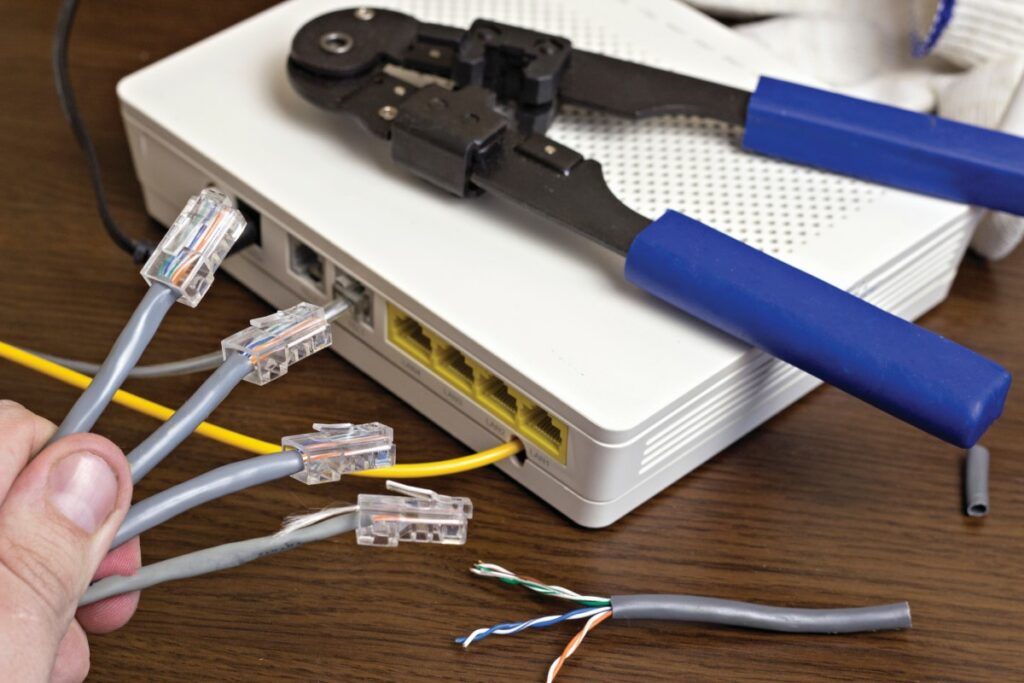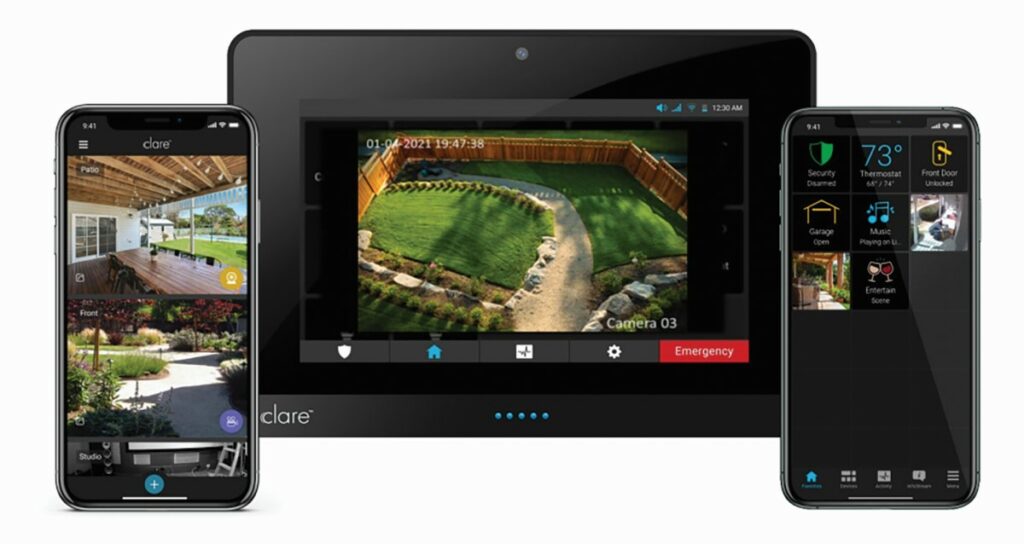How to Ramp Up Your Residential Network Revenues Routine
Security dealers are ideally positioned to become the go-to source to keep home networking infrastructure shipshape and minimize downtime.

(Image: Proxima Studio/stock.adobe.com)
Home networks are the backbone of modern communications. They allow homeowners to have instant control of unlimited technologies — their entertainment systems, security systems, surveillance and beyond.
Historically, security integrators have long understood that a reliable Internet connection is required to maintain user satisfaction and ensure home protection. But the reality is, the networking needs of average homeowners has grown significantly in recent years amid an explosion of new products, services and standards.
Depending on occupancy and lifestyle, a modern American home may have several dozen devices connected to the Internet at any given time, including TVs, cameras, security panels and sensors, smart speakers, thermostats, control systems, video doorbells, mobile devices, watches, appliances, exercise equipment and more.
This trend is forecast to accelerate in the coming years with even more Internet-connected devices and systems being developed under the umbrella of the Internet of Things. Residential security integrators have an immediate opportunity to add network design and installation to their service offerings.
In fact, security integrators are perfectly positioned to expand into professional-grade residential networks because they are often the first systems integrators to become involved in a project, giving them the first chance to inform owners of the benefits of a professionally installed network.
Security firms that add networking capabilities also gain a powerful tool to strengthen existing client relationships and expand service contracts that provide steady revenues.
Homes of all sizes can benefit from better networking gear that provides reliable house-wide coverage, supports modern bandwidth needs and can handle the large number of connected devices in today’s home.
Personalized service and troubleshooting can also be improved through the use of remote monitoring equipment that enables integrators to view and make changes to the network without requiring a site visit. With fewer truck rolls and much faster issue resolution, staff has more time to focus on new installations and sales, further helping a company’s bottom line.
These new growth opportunities come with a few requirements and costs, including the need for experienced staff who can design effective systems using leading components from trusted manufacturers. Therefore, integrators can either hire industry pros who have extensive network experience, or train existing staff with the help of distributors and partners that often provide training materials or even full classes to promote growth.
The Pro Network Difference
Most homeowners know that a smart home security and surveillance system designed and installed by professionals will outperform any possible solution they could buy themselves. While professional home networks are superior to self-installed solutions, dealers may need to educate homeowners on their value and benefits if they’ve never used one before.

Modern home networks should be considered a utility on par with electricity and water … vital infrastructure that must work all the time (Image: HENADZY/stock.adobe.com).
For clients who were previously satisfied with the basic solutions from their Internet service provider, it’s useful to come armed with specific examples that help define how much better a professional solution is.
Designing and implementing a robust network starts with a full analysis of the clients’ needs and usage scenarios, along with a strong knowledge of networking fundamentals and standards.
One obvious difference is the equipment itself, which is generally more expensive but also more reliable, more powerful, built with better components and can be selected for specific capabilities to meet each home’s needs. That being said, these are not cookie-cutter, off-the-shelf solutions.
A full solution may include a routing appliance, a firewall, wireless access points, switches, cybersecurity and conveniently located in-wall Ethernet ports.
The remote monitoring aspect is a major advantage for both the user and the integrator, as are power protection and battery backup systems that provide emergency power to ensure safe equipment shutdowns in the event of a power interruption.
There are various remote monitoring solutions that provide different levels of access and equipment management, up to and including the ability to cycle power for modems, routers or WAPs.
Most of these provide an online dashboard or mobile app that displays the status of all connected devices and can send push alerts to integrators, enabling rapid issue resolution, often before the homeowner is even aware there was a problem.
It takes training and experience to design and install a reliable system that’s easy to use and provides room for future upgrades and expansion.
While self-installed home networks are generally not designed for growth or changes in usage, a professional system includes hardwired Ethernet options, upgradeable switches, proper placement of access points and extra connections for expansion so it is always ready to support the next generation of Internet technologies and content.
How to Get Started
Security integrators looking to add network design to their services must first evaluate their own capabilities, knowledge, staffing and supply chains to determine their strengths and weaknesses. Partner distributors and manufacturers can make the process easier, often providing valuable training resources to help integrators stay up-to-date on new products, regulations and standards.
Some even offer free design and engineering assistance, which can be extremely valuable when branching into new markets. This practice enables integrators to test the waters and bid on network jobs without hiring new staff or spending time and resources on extensive training.
Select manufacturers and distributors go above and beyond to offer fully managed solutions (usually for a fee) that include system design, product selection and preconfiguration so all the integrator must do onsite is physically install and connect the equipment.
Fully managed solutions can also include manufacturer or distributor support for a set number of years, ensuring the integrator will always have the help they need to maintain their clients’ networks.
These partner programs can help a security firm enter the networking space, and then provide training and ongoing support if a firm decides to expand or train staff to grow their network installation capabilities.

The connected devices trend is forecast to accelerate in coming years with even more being developed under the umbrella of the Internet of Things (IoT).
Dispelling Client Myths
Part of the job of a network integrator is helping homeowners understand why a professional-grade network is better for them and how it will improve their home life. The most obvious myth that many people believe today is that wireless connections offer equal performance to hardwired connections.
WiFi is indeed a powerful, popular technology that enables our modern habits, but it is ultimately a tool of convenience. Hardwired Ethernet connections using Cat-5 or -6 cable deliver greater bandwidth, reduced lag time and nearly unimpeachable device connectivity to the home network.
This can be particularly beneficial for security sensors and devices, as they are the last devices any homeowner wants to suffer from disconnection or weak signal.
Another false belief clients may hold is that a network will simply work uninterrupted without requiring any maintenance or oversight. Here, explaining the capabilities of remote management solutions play a vital role in ensuring long-term satisfaction with the network.
Not only can it provide faster issue resolution and help homeowners avoid service interruptions, it also greatly reduces the chance that a technician will need to visit the home for simple troubleshooting. Integrators benefit because they don’t have to roll trucks and devote time to solving minor issues, and homeowners benefit by reducing the need to schedule home visits.
Consistent operation and problem solving also helps build and maintain the customers’ trust, which is vital for continuing service contracts.
The last major misconception a homeowner may express is that they are qualified and capable of installing a comparable networking solution with store bought components. This is almost never the case unless they have direct experience with IT or systems integration.
Big-box stores and online vendors promote a lot of DIY products and solutions that can improve existing home networks, but the products themselves are not a complete solution. When something malfunctions, the user will still have to troubleshoot and potentially deal with cascading issues such as smart devices not working, control systems becoming unresponsive, or lapses in security or surveillance coverage.
The essential message is that nearly every device in a modern home relies on the network, making the network itself the most important technological component and the one most worthy of investment.
Reaping the Rewards
Tackling new projects and adding new capabilities has obvious revenue benefits for security integrators. In particular, network installations that include remote monitoring and management contracts can deliver long-term rewards with minimal labor requirements.
Because security integrators may already have processes and systems in place for managing service contracts, they are well-positioned to add remote monitoring contracts without incurring back-end setup costs.
As technicians’ confidence and capabilities grow, networking expertise can even help residential integrators branch into other markets such as restaurants and retail establishments that share many of the same networking needs as homes.
If an integrator becomes known as an expert in networking, it can also lead to upgrades for existing clients or networking projects with new clients that already have security systems they like.
The bottom line is that modern home networks should be considered a utility on par with electricity and water, and just like those vital infrastructure systems, it must work all the time.
Ambitious security integrators can leverage their existing skillsets, workforces and available assistance from partners to offer their clients a superior home networking experience.
Clint Choate is Security Senior Director of Security Market for Snap One.
If you enjoyed this article and want to receive more valuable industry content like this, click here to sign up for our FREE digital newsletters!

Security Is Our Business, Too
For professionals who recommend, buy and install all types of electronic security equipment, a free subscription to Commercial Integrator + Security Sales & Integration is like having a consultant on call. You’ll find an ideal balance of technology and business coverage, with installation tips and techniques for products and updates on how to add to your bottom line.
A FREE subscription to the top resource for security and integration industry will prove to be invaluable.







